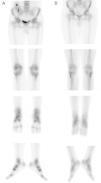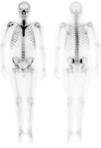We present the case of a 28-year-old Caucasian male diagnosed at the age of 4 months with chronic pyelonephritis secondary to vesicoureteral reflux that required treatment with haemodialysis. He had undergone transplantation from cadaveric donor 15 years earlier; induction therapy included corticosteroids, mycophenolate mofetil, tacrolimus and basiliximab and the later was discontinued for maintenance immunosuppressive therapy. Graft function immediately after transplantation was satisfactory, and no proteinuria was detected. One month after the transplant, he developed diabetes mellitus, requiring insulin. Immunosuppression was switched from tacrolimus to cyclosporin A.
Seven years later, the patient developed normochromic, normocytic anaemia with haemoglobin levels of 9.2mg/dL and haematocrit 28%. Treatment with subcutaneous epoetin beta was initiated, 10,000IU per week. Three months later, he came to the clinic for severe bilateral, asymmetric pain in ankles and knees, with difficulty to walk. No history of trauma was identified. Clinical examination revealed inflammatory signs in periarticular soft tissues in the lower extremities. Electromyography did no show signs of peripheral neuropathy that could have been explained by the diabetes. Results from blood and urine laboratory test results were: creatinine: 1.5mg/dL, urea: 72mg/dL, 24h urinary protein: 854mg, total calcium: 9.5mg/dL (reference values [RV]: 8.5–10.5), phosphate: 4.5mg/dL (RV: 2.3–4.3), PTH: 95pg/mL (RV: 15–65), alkaline phosphatase: 127U/L (RV: 90–290), C reactive protein: 0.1mg (RV: <0.8mg/dL), uric acid: 7.8mg/dL (RV: 1.9–7.4mg/dL), serum HbA1c 6.6% (RV: 3.4–5.5%) and cyclosporin A: 111ng/mL. Bone scintigraphy revealed generalised increased uptake by bone structures suggestive of a metabolic pattern related to his hyperparathyroidism. Also notable was evident bilateral symmetrical increased uptake in the osteoarticular structures of the hips, knees, ankles and feet, consistent with complex regional pain syndrome (CRPS), which confirmed the clinical suspicion (Fig. 1A).
The symptoms gradually resolved after discontinuing the epoetin, until complete improvement. Follow-up bone scintigraphy showed normalisation of the previously observed abnormalities in the lower extremities (Fig. 1B). The whole body scan continued to show an uptake pattern typical of patients with hyperparathyroidism, as in this case (Fig. 2).
CRPS is characterised by the presence of pain that is disproportionate in time or degree with respect to any known trauma or lesion, together with warmth and inflammation, combined with sensory, autonomic, trophic, sudomotor and vasomotor abnormalities. In order to make the correct diagnosis, there must be an initiating noxious event or a cause of immobilisation.1 In this patient, the initial event was the subcutaneous injection of erythropoietin (EPO). Bone scintigraphy was consistent with CRPS, with these findings key for the diagnostic confirmation. Finally, the patient's significant clinical improvement after withdrawal of the EPO with no other therapeutic intervention suggests that this was a case of CRPS associated with EPO treatment.
EPO is a glycoprotein produced mainly by the interstitial fibroblasts in the peritubular renal cortex. Patients with advanced chronic kidney disease (CKD) eventually develop normochromic, normocytic anaemia due to reduced endogenous synthesis of EPO. Moreover, anaemia in patients with diabetic nephropathy usually appears very early. EPO and its derivatives have been widely used for the treatment of the anaemia of CKD, and its cardioprotective and neuroprotective effects are well known.2,3 It has also been reported that the administration of EPO may protect against the development of the sensory and autonomic peripheral nerve dysfunction that results from diabetes.4 In this case, the patient was diabetic with no known polyneuropathy, and developed CRPS after subcutaneous EPO administration.
At present, the onset of CRPS has been described in association with drugs, such as calcineurin inhibitors and sirolimus in transplant recipients, isoniazid and phenytoin or phenobarbital.5–7 Nevertheless, the development of CRPS associated with EPO therapy has not been described to date. In this case, the patient had been under cyclosporin treatment for years, and while there is no temporal relationship between the start of cyclosporin administration and the onset of CRPS to explain the symptoms, it could be a predisposing factor for the development of this syndrome.
In conclusion, this case shows the possible relationship between the administration of EPO and the onset of CRPS, since the withdrawal of EPO resulted in complete clinical resolution in the patient. This case is the first description of CRPS secondary to the administration of EPO, although further studies are recommended to support this association.
Please cite this article as: Coloma A, Sánchez N, Fuster D, Ruiz C, Xipell M, Orozco J, et al. Síndrome de dolor regional complejo asociado a terapia con eritropoyetina. Nefrología. 2018;38:99–101.












